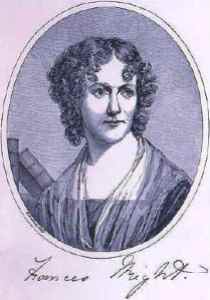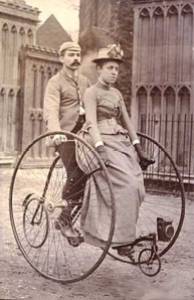
In 1920, when Warren G. Harding was running for President of the United States, he had secrets to hide, many secrets; and they all had female names. In fact, one of his mistresses is the only person, that we know of, to successfully blackmail a presidential nominee. But, he wasn’t the only one with a past that they wanted to keep hidden. His wife Florence had a few indiscretions of her own.
Florence Kling Harding was supposed to be a boy, at least in the mind of her father. When Amos Kling and his wife, Louisa, were expecting their first child, he told everyone around town in Marion, Ohio, that the child would be a boy. Aside from just wanting a boy, Amos owned a successful hardware store which required much of his time; a son could work along side him and eventually take over the business. So on August 15, 1860 when Florence Mabel, Flossie, was born, although Amos resented the fact that she wasn’t a boy, he had a practical solution. He would raise her as if she were a boy.
From the time Flossie could walk, Amos took her with him to the store. It became an environment that she would always be comfortable in, the sights, smells, sounds, and the company of men. As she grew, Amos trained her in the running of the store and his other businesses as they came about. By the time Flossie was a teenager, Amos had expanded into banking, real estate, and land/tenant management. He had also become a very wealthy man.
Florence’s education was extensive, including subjects not always studied by women such as math, rhetoric, logic, Greek, and Latin. She was also very active physically, running and playing with the neighborhood boys. Her favorite outdoor activity was horseback riding. Many of her Marian neighbors commented that she was the best horsewoman they had ever seen. (I suspect she was better than many of the men as well.)
All of this continued in spite of the fact that Florence had two younger brothers. Amos never switched his training to the boys. He was a tyrant in the home and it seems that Louisa and the two boys were more submissive, and thus less like Amos in personality than Florence. She was just as competitive and driven as he was and perhaps that’s why he seemed to favor her, but as is the case with many strong-willed children of overbearing parents, there came a time when Florence rebelled against Amos’ demands.
Florence also showed a talent for music. She spent hours practicing the piano, one time for eight hours, until her fingers bled. Music for the sake of art didn’t mean anything to Amos, but he was a firm believer that a woman should be able to provide for herself if necessary. For this reason, he allowed Florence to enroll at the Cincinnati Conservatory of Music, so that she would have a means to support herself by giving piano lessons. Her ambition, however, was to become a concert pianist.
Cincinnati was the country’s center of culture in the west and it opened up a new world to Florence. A world that she reveled in, a world with new people and experiences, but more importantly, a world of independence. After only a year, Amos called Florence home. Whether it was to take care of things at home while her mother was ill, as he said, or because he wanted to reign in his newly liberated daughter, I don’t know. But whatever the reason, he released a tiger that he couldn’t put back in the cage.
Amos tried to impose his own standards on Florence once again and their arguments were long and loud, sometimes lasting all night and heard in the street outside their home. More than once he locked her out of the house when she didn’t return before curfew. Sometimes she crawled into the window of her best friend Carrie Phillips, but other times who knows. Amos particularly disliked the fact that she was *gasp* hanging around the new roller rink in town.
Roller skating was a new fad that was sweeping the country. It gave young men and women a chance to socialize and listen to music, and if a few proprieties were breached well, you had to keep your balance, right? In fact the Philadelphia Inquirer in 1885 passed on a minister’s warning that roller skating rinks “corrupt the morals of all who associate with them.” As might be expected, it wasn’t long before Florence became interested in a young man, Henry De Wolfe, Pete to his friends. Amos was livid, which of course made Pete that much more attractive.
For young women who feel trapped at home, there is one way of escape which has often been used, although it can sometimes have dire consequences. Florence had never expressed a desire to marry or have children and a family like her mother. She had been greatly inspired by Clara Baur, the unmarried founder of the Cincinnati Conservatory of Music who was a proponent of careers for women. But at the end of 1879, she found herself in trouble. Trouble that could provide a way out of her father’s house.
Kathleen Lawler, Florence’s long-time assistant said that Florence became pregnant to get away from Amos. Florence herself didn’t admit it, but in her diary early in 1880, she makes a cryptic statement: “Vice often comes in at the door of necessity, not at the door of inclination.”
Pete was fun-loving and handsome, and he drank to excess. Just a year older than Florence, they grew up across the street from each other. Pete’s father, Simon, was one of the few men in town who wasn’t afraid of Amos Kling and there was no love lost between the two, so when Pete and Florence took up with each other people held their breath waiting for the explosion which was sure to occur. Neither family approved, but Simon was a different kind of man than Amos and when Pete told him that he had gotten Florence pregnant, Simon told him to take her up to “Columbus, and get married as soon as possible.” So in March 1880, Florence and Pete eloped to Columbus to get married. But, they didn’t.
Carl Anthony, Florence’s biographer, states in his book that there is no record of a marriage between a Kling and a DeWolfe for 10 years before or after 1880 in Franklin County (Columbus), Marion County, or in Crawford County, where they soon set up housekeeping. Florence may or may not have wanted it that way, but Amos had to believe that they were married to prevent him trying to force her back home. And it worked. Not only did Amos leave Florence to her “marriage”, he cut her off and refused to talk to her.
Life with Pete was difficult. They tried to run a roller skating rink, but failed, and Pete didn’t adjust well to the responsibility of a family. He would be gone for days at a time and finally, before their son Marshall was two years old, he deserted them. Florence had no choice except to return to Marion. A friend’s father was kind enough to allow her to stay at their house as she began to teach piano lessons, until she finally was able to raise enough to get a small apartment of her own.
Even though Florence’s marriage was from all appearances a common law marriage, she did finally get a divorce from Pete in 1886. At that time there was some communication between Amos and Florence and he offered to provide for Marshall. The conditions were that Marshall would live in the Kling home and take the Kling name. Florence agreed.
Amos may have hated losing control of Florence, and hated the choices she made, but he had given her the tools to make them. She was now on her own, independent, free of responsibility for anyone but herself, and she set out to start over. She also set her sights on the dashing young publisher of The Marion Star, Warren G. Harding.
Resources
First Ladies: From Martha Washington to Michelle Obama by Betty Caroli
Florence Harding: The First Lady, The Jazz Age, and the Death of America’s Most Scandalous President by Carl Sferrazza Anthony
Presidential Wives: An Anecdotal History by Paul F. Boller Jr.
The Library Company of Philadelphia: “Roller Skating Fun“





















